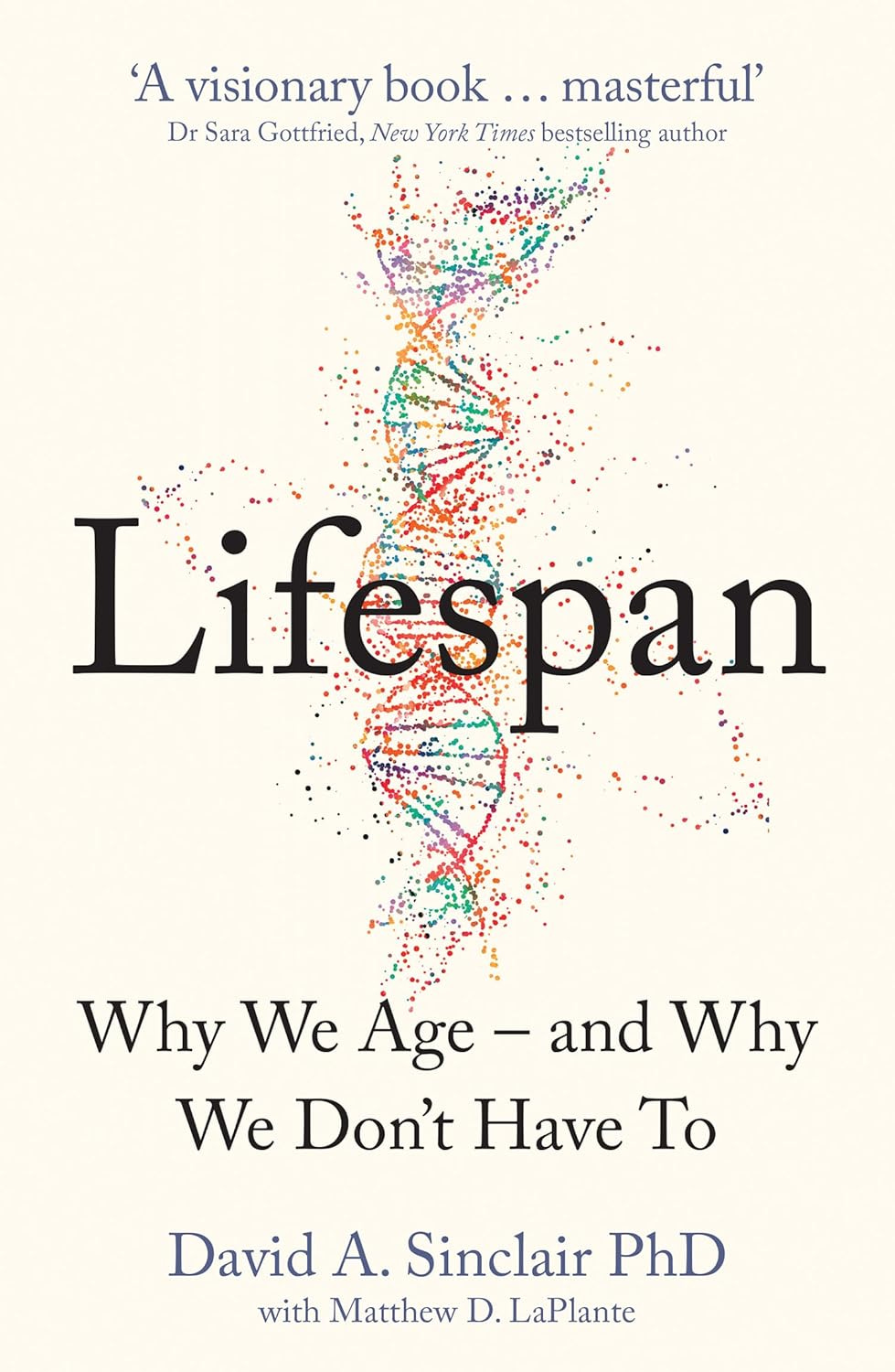Lifespan - Why We Age and Why We Do NOT Have To, by David Sinclair
Each month there will be a synopsis of a book on the science of longevity, if you find this helpful, I encourage you to purchase the book for your collection.
This was a great and easy-to-understand read; if you want to understand the emerging science of the field of longevity, this is the starting point and I highly recommend it.
Main Themes and Concepts
1. Aging is a Disease
Sinclair challenges the conventional belief that aging is a natural and unavoidable process. Instead, he argues aging should be viewed as a disease—a pathological process that can be studied, treated, and eventually cured or slowed.
“Aging is far more treatable than we've been led to believe.”
2. The Information Theory of Aging
Sinclair introduces the Information Theory of Aging, based on the idea that aging results from the loss of epigenetic information—the software that tells the cellular hardware (our genes) how to operate. As this information degrades over time due to damage and errors, cellular function declines.
DNA mutations are not the main cause of aging.
Epigenetic "noise" and loss of instruction to cells are what drive aging.
Sirtuins, NAD+, and other regulators help preserve epigenetic stability.
3. Longevity Genes and Sirtuins
The book discusses “longevity genes”, particularly the sirtuin family of genes (SIRT1–SIRT7), which are involved in cellular repair, DNA stability, and metabolic regulation. Sinclair’s research focuses on activating these genes through environmental and pharmacological triggers.
Sirtuins need NAD+ (nicotinamide adenine dinucleotide) to function.
NAD+ levels decline with age, leading to reduced repair activity and increased aging.
Boosting NAD+ is a key strategy.
4. Hormesis and “Good Stress”
Sinclair introduces hormesis—the idea that exposing the body to low-level stressors can activate longevity pathways. The body thrives when it is challenged, which triggers survival mechanisms that promote repair and resilience.
Examples of hormetic stressors:
Intermittent fasting
Exercise
Cold exposure
Heat exposure
5. Biotechnology and the Future of Aging
A significant portion of the book explores emerging biotechnologies that may radically change how we age, including:
Gene therapy to reset epigenetic clocks
Senolytics to clear damaged cells
NAD+ precursors (e.g., NMN, NR) for cellular energy
Artificial intelligence and diagnostics
Actionable Steps to Extend Lifespan (Sinclair’s Personal Protocol)
Throughout the book and in interviews, Sinclair shares personal and science-backed strategies that readers can consider adopting. He presents these as practical steps aligned with activating longevity genes.
1. Caloric Restriction & Intermittent Fasting
Eat less frequently to trigger autophagy and sirtuin activation.
Skip one or two meals per day.
Consider time-restricted eating (e.g., eating within an 8-hour window).
Avoid eating three hours before bed.
2. Plant-Based and Low-Protein Diet
Favor plant-based foods and reduce animal protein intake.
Lower branched-chain amino acids (BCAAs) to reduce mTOR activation.
Occasional protein restriction supports longevity.
3. Exercise Regularly
Engage in high-intensity interval training (HIIT).
Strength training and cardio promote mitochondrial health.
Exercise increases NAD+ levels and activates AMPK.
4. Cold and Heat Exposure
Use cold showers or ice baths occasionally to activate stress responses.
Sauna use can induce heat shock proteins that improve cellular resilience.
5. Supplementation (David Sinclair's Regimen)
He shares his own supplement routine (not medical advice, but for informational purposes):
NMN (Nicotinamide Mononucleotide) – 1g/day to boost NAD+
Resveratrol – 1g/day with yogurt for absorption (activates sirtuins)
Metformin (off-label use) – prescribed to reduce blood sugar and activate AMPK (not recommended for those without metabolic issues)
Vitamin D3 + K2
CoQ10 (especially if taking statins)
Low-dose aspirin (to reduce inflammation and cancer risk)
Fisetin and quercetin (possible senolytic agents)
6. Avoid Harmful Lifestyle Factors
Avoid excessive sun exposure and tobacco.
Limit processed foods and sugar.
Reduce chronic stress through mindfulness, purpose, and social connection.
7. Stay Informed & Embrace Technology
Sinclair encourages readers to track biomarkers of aging (biological age testing).
Monitor glucose, inflammation markers, lipids, and more.
Key Takeaways and Learning Outcomes
Takeaway
Learning Outcome
Aging is treatable
Readers learn to shift their perspective from passive acceptance of aging to proactive management.
Epigenetics matters
Understanding how epigenetic regulation deteriorates with age empowers readers to engage in habits that preserve cellular health.
Stress your body (mildly)
Intermittent fasting, exercise, and hormesis build resilience and activate longevity genes.
Supplements can support longevity
The book provides insight into compounds that boost NAD+, activate sirtuins, and fight cellular senescence.
Future tech is promising
Readers gain awareness of near-future interventions like gene editing, cellular reprogramming, and AI-driven medicine.
Critical Reception and Considerations
Strengths:
Groundbreaking insights into molecular aging.
Blends scientific rigor with personal narrative.
Encourages optimism around healthspan and lifespan.
Critiques:
Some suggestions (e.g., use of metformin or NMN) are not yet FDA-approved for aging and may lack long-term safety data.
Certain claims are more speculative than others, relying on early animal or preclinical research.
Readers should approach supplement use cautiously and consult health professionals.
Conclusion
Lifespan is a paradigm-shifting book that redefines aging as something we can slow down, reverse, and eventually control. Dr. David Sinclair delivers a hopeful yet evidence-informed roadmap to help readers enhance longevity through behavioral changes, dietary practices, and emerging science.
While some of the interventions are still in development, many actionable habits—like fasting, plant-based eating, exercise, and stress modulation—are immediately implementable and backed by both Sinclair's research and broader scientific consensus.





I have read (through many sources) that one of the major factors in age-related decline is loss of muscle mass. How does protein restriction fit with that?